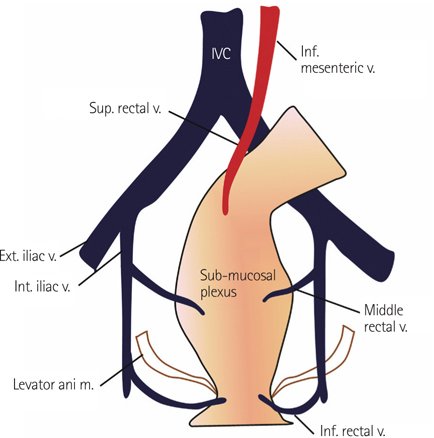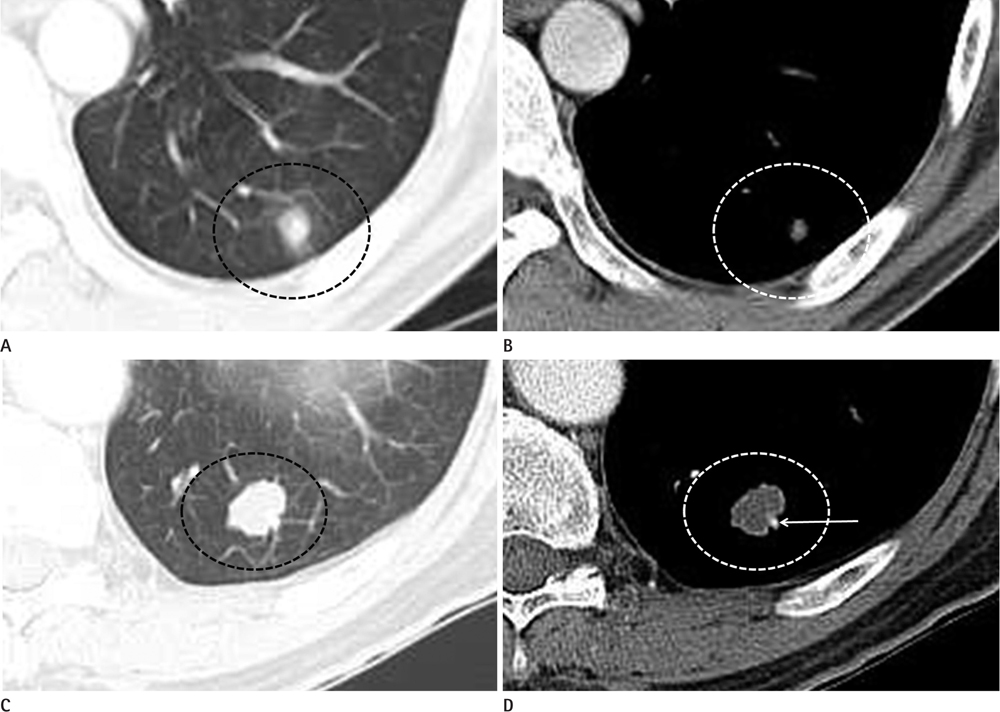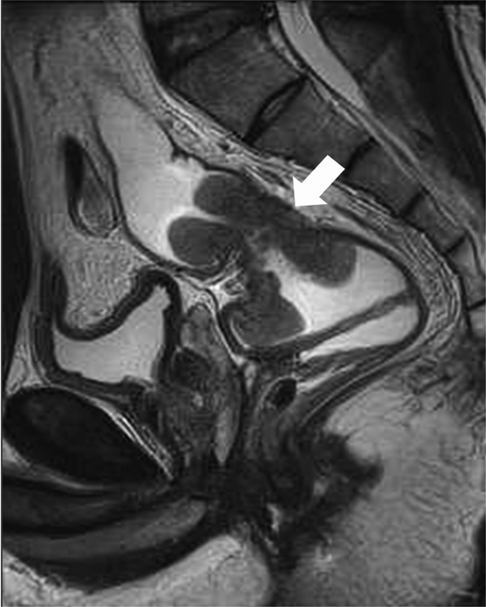J Korean Soc Radiol.
2011 Aug;65(2):151-159. 10.3348/jksr.2011.65.2.151.
Pulmonary Metastasis from Rectal Cancer on Chest CT Is Correlated with 3T MRI Primary Tumor Location
- Affiliations
-
- 1Department of Radiology, Anam Hospital, Korea University College of Medicine, Seoul, Korea. dr.minjukim@gmail.com
- KMID: 1443479
- DOI: http://doi.org/10.3348/jksr.2011.65.2.151
Abstract
- PURPOSE
To evaluate the association between the incidence of pulmonary metastasis on chest CT and the location of the primary tumor on rectal MRI.
MATERIALS AND METHODS
One hundred and nine consecutive patients with rectal adenocarcinoma underwent chest CT and 3T rectal MRI. Two radiologists classified the tumor on MRI as an upper (> 10 cm from the anal verge), mid (5-10 cm), or lower rectal tumor (< 5 cm) by consensus. All chest CT scans were retrospectively reviewed for the presence of metastasis. We used Fisher's exact test to evaluate the correlation between the incidence of pulmonary metastasis with the location of the rectal cancer and the Mantel-Haenszel test to control for local tumor stage.
RESULTS
We only included the 60 patients with upper (n = 26) or lower (n = 34) rectal cancer, because of the complicated venous drainage system of the mid rectum. Among these, 9 (15%) showed evidence of pulmonary metastasis on chest CT and almost all (89%, 8/9) patients had lower rectal cancer. The incidence of pulmonary metastasis between the two groups was statistically different (p < 0.05) when local tumor stage was controlled.
CONCLUSION
The incidence of pulmonary metastasis was significantly higher for lower than upper rectal cancers when the T-stage of the tumor was accounted for.
MeSH Terms
Figure
Reference
-
1. Jung KW, Park S, Kong HJ, Won YJ, Lee JY, Park EC, et al. Cancer statistics in Korea: incidence, mortality, survival, and prevalence in 2008. Cancer Res Treat. 2011; 43:1–11.2. Tan KK, Lopes Gde, Sim R. How uncommon are isolated lung metastases in colorectal cancer? A review from database of 754 patients over 4 years. J Gastrointest Surg. 2009; 13:642–648.3. Parnaby CN, Bailey W, Balasingam A, Beckert L, Eglinton T, Fife J, et al. Pulmonary staging in colorectal cancer: a review. Colorectal Dis. 2012.4. Sakamoto T, Tsubota N, Iwanaga K, Yuki T, Matsuoka H, Yoshimura M. Pulmonary resection for metastases from colorectal cancer. Chest. 2001; 119:1069–1072.5. Welton ML, Pineda CE, Chang GJ, Shelton AA. Anorectum. In : Doherty GM, editor. Current Diagnosis & Treatment: surgery. 13th ed. New York: McGraw-Hill;2009. p. 698–723.6. Zhang XM, Zhang HL, Yu D, Dai Y, Bi D, Prince MR, et al. 3-T MRI of rectal carcinoma: preoperative diagnosis, staging, and planning of sphincter-sparing surgery. AJR Am J Roentgenol. 2008; 190:1271–1278.7. Taylor FG, Swift RI, Blomqvist L, Brown G. A systematic approach to the interpretation of preoperative staging MRI for rectal cancer. AJR Am J Roentgenol. 2008; 191:1827–1835.8. Kirke R, Rajesh A, Verma R, Bankart MJ. Rectal cancer: incidence of pulmonary metastases on thoracic CT and correlation with T staging. J Comput Assist Tomogr. 2007; 31:569–571.9. Grossmann I, Avenarius JK, Mastboom WJ, Klaase JM. Preoperative staging with chest CT in patients with colorectal carcinoma: not as a routine procedure. Ann Surg Oncol. 2010; 17:2045–2050.10. Kosmider S, Stella DL, Field K, Moore M, Ananda S, Oakman C, et al. Preoperative investigations for metastatic staging of colon and rectal cancer across multiple centres--what is current practice? Colorectal Dis. 2009; 11:592–600.11. Kronawitter U, Kemeny NE, Heelan R, Fata F, Fong Y. Evaluation of chest computed tomography in the staging of patients with potentially resectable liver metastases from colorectal carcinoma. Cancer. 1999; 86:229–235.12. McIntosh J, Sylvester PA, Virjee J, Callaway M, Thomas MG. Pulmonary staging in colorectal cancer--is computerised tomography the answer? Ann R Coll Surg Engl. 2005; 87:331–333.13. Van Cutsem E, Oliveira J. ESMO Guidelines Working Group. Primary colon cancer: ESMO clinical recommendations for diagnosis, adjuvant treatment and follow-up. Ann Oncol. 2009; 20:Suppl 4. 49–50.14. National Comprehensive Cancer Network (U.S.). Clinical Practice Guidelines in Oncology - v.2. 2009. [CD-ROM]. Rockledge: NCCN;2009.15. Penna C, Nordlinger B. Colorectal metastasis (liver and lung). Surg Clin North Am. 2002; 82:1075–1090. x–xi.16. Barlow AD, Nakas A, Pattenden C, Martin-Ucar AE, Dennison AR, Berry DP, et al. Surgical treatment of combined hepatic and pulmonary colorectal cancer metastases. Eur J Surg Oncol. 2009; 35:307–312.17. McAfee MK, Allen MS, Trastek VF, Ilstrup DM, Deschamps C, Pairolero PC. Colorectal lung metastases: results of surgical excision. Ann Thorac Surg. 1992; 53:780–785. discussion 785-786.18. Kim CK, Kim SH, Chun HK, Lee WY, Yun SH, Song SY, et al. Preoperative staging of rectal cancer: accuracy of 3-Tesla magnetic resonance imaging. Eur Radiol. 2006; 16:972–980.
- Full Text Links
- Actions
-
Cited
- CITED
-
- Close
- Share
- Similar articles
-
- Endotracheal Metastasis Seen on FDG PET/CT in a Patient with Previous Colorectal Cancer
- The Role of Preoperative Chest CT in the Evaluation of a Colorectal Adenocarcinoma
- Interpretation of Rectal MRI after Neoadjuvant Treatment in Patients with Rectal Cancer
- Diagnostic Performance of Rectal CT for Staging Rectal Cancer: Comparison with Rectal MRI and Histopathology
- Predictive value of chest computed tomography for axillary lymph node metastasis in patients with breast cancer A retrospective cohort study






